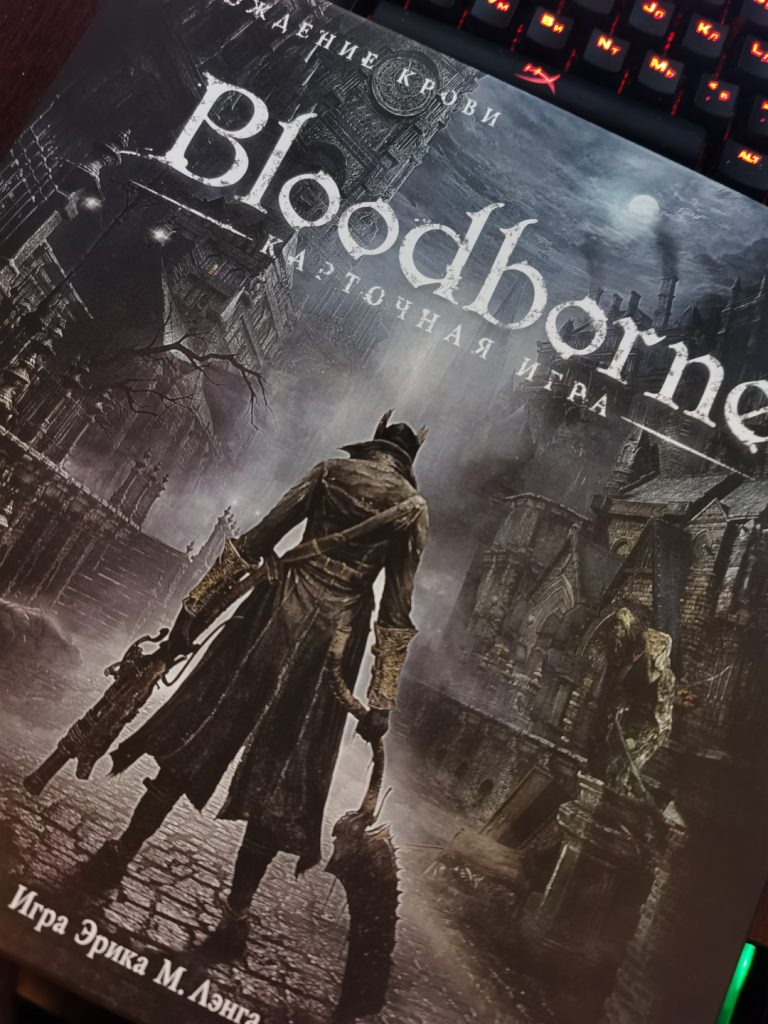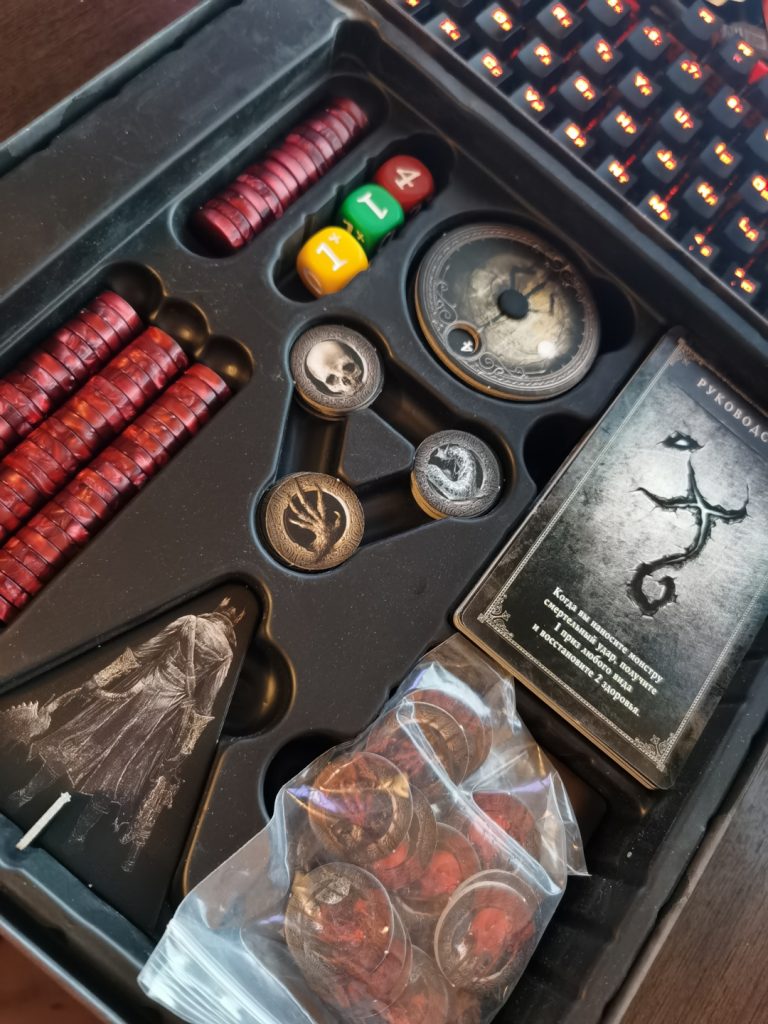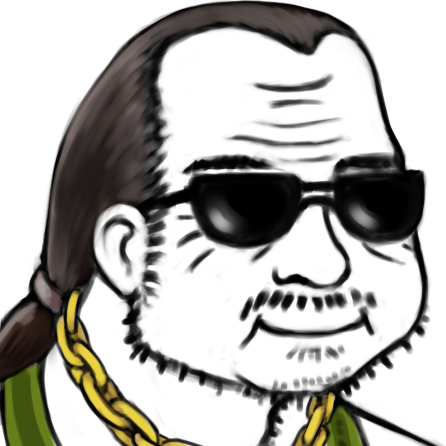Back home from my summer house adventure with friends and one of our main evening activities after some good bbq and while drinking some beer was playing tabletops, or rather playing Bloodborne Card Game mostly, since everyone was curious and it actually turned out really good.
Gonna post some pics this time to help explain some details and show it, should post more pics in general, but in some posts it just feels kinda weird and forced just to put some random pic in. So here we go with “YOU DIED” in tabletop form…
Bloodborne Card Game is not fully a card game, so don’t be afraid of some overly 5Head action like in MTG and such, far from something like Monopoly too of course, but I think that’s for the best. So how does it work? General concept is pretty simple and close to the game – you play as hunters going into Chalice Dungeon to fight against a mix of bosses and regular mobs to face the main boss of the run, during the run you get blood echoes and “trophies” from participating in monster/boss kill, so when run is over you sum it all up and get your score that you compare to others and decide who won. Obviously it is Bloodborne still, so if you die (you have special HP counter that you move when you take damage) – you lose all your blood echoes, BUT you can return to Hunter’s Dream from time to time and save them in the bank (also heal and get new cards), otherwise there is no permanent “death” (there is an exception that at least one of the bosses abilities imposes, more about abilities later), so you are always playing and not waiting for others to finish to join next run, just minor setback and you are back in action next round. Hunters are using full assortment of items and equipment that you know from the game, all the mobs and bosses are also familiar faces, so overall it’s really close to the game with setting and general vibe.

Without going technical game basically is co-op experience and instead of directly playing against others you play together, but you are interested in some sneaky moves and 5Head plays that would kill your competitors or make them miss their blood echoes/trophies from attacking the enemy. Since there is (almost) no perma death or losing in general no one feels left out and it doesn’t really feel that “intimidating” to be low on score or something, because technically you are not directly competing with each other and instead go for one common goal of killing main boss. Pretty sure more experienced you go and more 5Head you try to go, more sneaky moves and “griefing” against other hunters will happen, so friendship ruining potential is there if you want, like if one of your friends got a rune for ranged weapon synergy and motivated to pick more ranged weapons, but you get weapons and items that counter it (like one that forces everyone using ranged weapon to take double damage that round). Amount of RNG outside of dice rolls for enemy damage (more on that later if you are interested in mechanics) is very low – your “deck” is limited in size and you have full control over what to play, monster deck you can go full random or pick it yourself, shuffle or not, can have some kind of “dungeon master” approach there to plan the adventure, only upgrades deck is usual cardgame RNG (unless you go DM mode there too). So for me buying this game was totally worth, DLC too (will mention later what it adds), friends all liked it and way more than I think any other tabletop we played before, so pretty sure we will get even more fun evenings with this game later too.

Now a bit more details on how things work from technical perspective if you want some details, but gonna try to avoid going full rulebook here, just things required to understand how it works in general: all that equipment, items, mobs and bosses are cards, combat goes in rounds and round has multiple stages – hunters plan and play their actions (items/equipment they use), hunters transform some of their weapons if they used right cards (some weapons/abilities allow you to change them to something else when you see what others are playing, so it’s planning/mindgame thing), instant effects are being used (like using blood vial), enemy attacks (they all have colour that defines how dangerous they are and you pick matching colour dice to roll the damage they do to hunters), hunters attack (clockwise from the player that currently has 1st player marker), monster escapes or dies (bosses don’t escape so you go on a second circle of actions), hunters who used “hunter’s dream” card go to hunters dream to take all their used cards back in hand, refill HP and pick a new card to add to their deck (7 cards max, discard something if you go above), put new monster and start new round.

Monster HP = amount of echoes you can get from them, so attacking for more is not only killing them faster, but giving you more blood echoes for your win condition, monsters have race that defines what kind of “trophy” you move on your board if you damaged it. All that would be pretty simple, but lots of mobs and all bosses have special abilities aka text on the card that puts a twist on the round, main boss has text that puts a twist on a whole run from the beginning too and almost all equipment/items have some extra things on top of plain damage. This is where things become more interesting, because many of those extra abilities can alter the flow of the game and a lot of them allow you to make life of other hunters harder so they have troubles gathering echoes and trophies to win. Main game also has an expansion, that is basically Bloodborne DLC in card game form – adds whole bunch of new bosses, mobs, items and weapons mostly from DLC obviously, but not only. On top of that it adds Runes from the game, pretty much passive abilities each hunter picks from two random ones at the beginning of every run and also death “penalty” that decreases amount of trophies you can earn every time you die, to make deaths more punishing, so I can recommend to add it starting with first attempts and it totally feels worth, since it adds a lot of replayability and variety to the game.

Leave a Reply